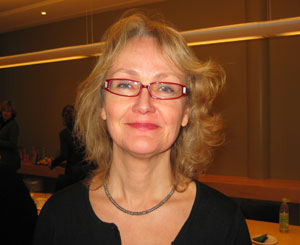An all-out effort for women
The Research Council of Norway is planning a large-scale initiative to increase the recruitment of women to high-level positions and research management.
“Following the EU ruling in 2003 that prohibited the earmarking of positions for women, we have been rather cautious about developing new measures to improve the gender balance in Norwegian research. Now we want Norway to move forward on this issue,” says Lise Christensen, Senior Adviser at the Research Council of Norway.
Christensen has been one of the driving forces behind the proposal to launch a large-scale initiative to improve the gender balance in the research sector, focusing in particular on the recruitment of women to high-level positions and research management. The proposal was approved by the Executive Board of the Research Council on 18 November 2010.
“We would like to see an initiative that runs for a seven-year period – from 2012 to 2018 – and has a start-up budget of NOK 25 million in the first year,” says Christensen.

Three-part initiative
The Research Council is currently considering a three-part approach to the challenge of recruiting more women.
1.) A grant scheme to assist female researchers with obtaining qualifications beyond the post-doctoral level. This scheme could also help to stimulate mobility between academia and the business sector, both nationally and internationally.
2.) Activities to increase the proportion of women in research management and to strengthen research directors’ expertise in gender-equality leadership, regardless of gender.
3.) An effort to learn more about the mechanisms that influence women’s decision to drop out of the research sector rather than pursue upper-level positions. The challenge related to temporary positions and the gender aspect of this challenge will also be closely examined. Research projects, seminars and network-building will be employed to gain more knowledge about this area.
A variety of challenges
“Although the problem of uneven gender balance spans the range of subject areas and disciplines, we believe that the specific challenges can vary from one part of the research world to another. For this reason, it is also important that we take different approaches to the problem,” says Christensen.
“Some subject areas have very few women among both doctoral and post-doctoral research fellows and professors. In these cases, a grant scheme that qualifies female researchers to obtain higher positions might be appropriate. Other subject areas have a good gender balance at the lower levels but are male dominated at the higher levels, and here it might be more important to target activities towards the research culture and management culture,” she continues.
In addition to increasing the proportion of female research directors, Christensen believes that more expertise is needed among leaders in the research sector.
“Studies show that female researchers feel less valued and included in academic circles than their male colleagues. This is clearly a challenge for the leadership,” says Christensen.
Designing the initiative is the first step
The upcoming year will be dedicated to a knowledge project that will develop and specify the actual design of the initiative. Lise Christensen will head the project group, which will work from November of this year until November 2011.
“During the course of the year we will refine the initiative to make it as effective as possible. We will do this in cooperation with interested ministries, various academic communities, researchers and other relevant resource persons. We will also commission external assessments,” Christensen explains.

“Everyone agrees that we need more women in the research sector. By the same token, it is crucial that we design the measures in a way that avoids the risk of a new appeals case. The design is not completely finished, but we will get there,” she says with determination.
A catalyst is needed
The initiative requires a substantial amount of funding, according to Christensen.
“If we are going to have a grant scheme in the first place, then it needs to be of a certain size; otherwise there is no point. Relatively small sums are often allocated to gender-equality initiatives. One exception to this is the VINNMER project in Sweden. They have made a large investment and established effective grant schemes in the subject areas they are responsible for. We have taken our inspiration from the VINNMER scheme of individual grants, although we don’t intend to create a carbon copy. For example, we think it might be beneficial to establish different types of grants of different sizes.”
“Another inspiring aspect of the VINNMER project is that they have managed to obtain funding from the EU. I think we should also try to do this,” says Christensen.
The focus on recruiting women should also serve as a source of inspiration as well as a stimulus to ensure that the other funding instruments and programmes under the Research Council incorporate a gender perspective.
“We award just under NOK 7 billion each year, so it is crucial that the gender perspective is visible when we design programmes and activities. To achieve this better than we do today, I think we need a powerful catalyst and we will get such a catalyst with the new initiative.”
Part of a broader effort
Jesper W. Simonsen is Director of the Department of Global Issues at the Research Council and a member of the Committee for Gender Balance in Research (KIF). He has also been a driving force behind the initiative and is concerned that this initiative is part of a broader effort at the Research Council to increase the proportion of women in research.

“We have to make things happen throughout the entire organisation. A lot can be done with regard to the assessment of applications and the activities carried out by the various programmes,” he points out.
“We have just completed a review of our application assessment process. Consideration will now be given to whether the project managers place women in high-level positions and whether the project groups have a relatively even distribution of women and men. There are also many measures that can be implemented in the various programmes to promote women to the higher levels.”
Simonsen says that the proportion of women in high-level positions in the projects funded by the Research Council is below the national average. This is a situation he wants to change.
The institutions must also make an effort
“Although there is a great deal that the Research Council can do to improve the gender balance in research, there is also a lot that the research institutions must attend to. I see this in my work on the KIF Committee,” says Simonsen.
He explains that women drop out of the research sector not only due to direct obstacles but also because they make a conscious choice to leave.
“The institutions are not always seen as attractive workplaces, and this is a serious problem. In order for the institutions to secure good quality and skilled employees, they must be perceived as attractive; otherwise they risk losing good researchers, especially women. This situation requires effective leadership,” he says.
This article is translated by Connie Stultz.
